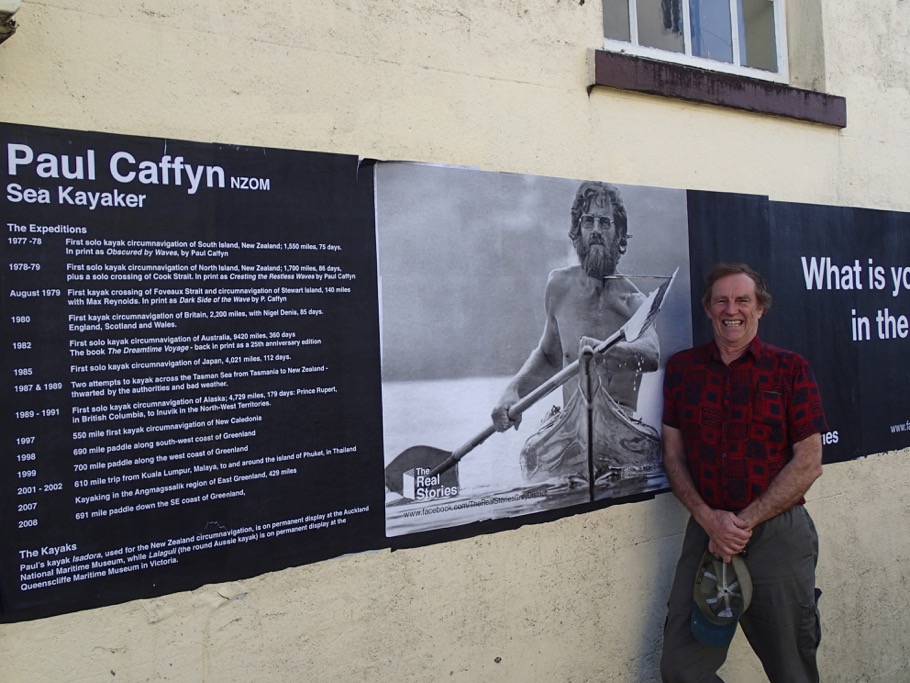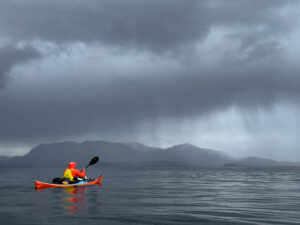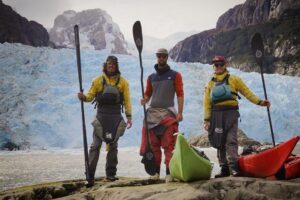The story of Paul Caffyn and perhaps the greatest sea kayak journey ever — 15,000km around Australia.
In 1982, 36-year-old Paul Caffyn completed a mind-boggling year-long paddle around Australia. The voyage required skill, strength, steely determination, and a fair dose of pigheadedness.
Caffyn was first introduced to canoeing on the Brisbane River at age nine, but it wasn’t until 1977, in his early thirties, that he began to take sea kayaking seriously. That year, Caffyn and his friend Max Reynolds left Te Waewae Bay, on the south coast of New Zealand’s South Island. They paddled together for 27 days, then Caffyn continued alone for another 49 days around the remainder of the South Island. Something about that journey appealed to Caffyn, and a long-distance kayaker was born.
The following summer, Caffyn circumnavigated New Zealand’s North Island in 86 days (He was on the water for 63 of those). He began in Makara and finished with a three-hour crossing of Cook Strait. In 1979, he and Reynolds teamed up again, crossing Foveaux Strait to complete a Stewart Island circumnavigation.
Caffyn had become the first person to circumnavigate New Zealand by kayak. Next, he decided to conquer Britain. In 1980, with English paddler Nigel Dennis, he completed the 3,500km circumnavigation.
Back then, there were no satellite phones, personal satellite communicators, or even civilian GPS units. It was imperative for paddlers to ensure that they could handle whatever lay ahead of them.
It began as a joke
Caffyn now had plenty of experience behind him. During a conversation with friends in his adopted homeland of New Zealand, they suggested that he should circumnavigate Australia. Although they were joking, the seed was planted.
But Australian seas pose more difficulties than both Britain and the famously rugged waters of New Zealand. A sea kayak circumnavigation of Australia had long been considered impossible. The section along the Zuytdorp Cliffs, bordering Western Australia and the Indian Ocean, is particularly hazardous for small craft since it’s a long stretch with nowhere to land.
“I’d worked as a geologist in Western Australia and I’d seen those cliffs…and the huge seas with the prevailing headwinds.” He needed a plan if he was to have even a chance to succeed.
His total sponsorship amounted to $100 off the cost of a support van
Recognizing that such a complex journey would cost a lot, he tried to find sponsorship. One filmmaker he approached wanted to stage a crocodile attack to “make it more exciting”. Strike out that guy.
Possibly the trip sounded laughable to sponsors, or even worse, too dangerous — a public relations disaster waiting to happen. The best offer he received was $100 off the cost of a van for the support crew that would bring him supplies.
In the end, he funded the trip himself. Caffyn and a partner launched themselves into the ocean at Port Phillip Bay, Queenscliff, Victoria, on December 28 1981. The two started paddling counter-clockwise around Australia.
After just a few days, however, they parted ways after a disagreement, and Caffyn continued alone. He used a two-way radio to communicate with a few friends on shore who had formed a support crew. They dropped food, camped, and paddled with him where possible.
Early in the voyage, Caffyn’s main challenge was the intense surf. Heavy waves dumped over the bow of his kayak, forcing the stern upright at times, even tearing his skirt. He’d handled rugged surf before when circumnavigating New Zealand, but that didn’t make it any less frightening.
Working in his favor was Caffyn’s tunnel vision, an ability to focus his mind solely on the objective. The waves demanded all his strength and skill, but it was ultimately his mind that helped him progress despite the many difficulties and setbacks.
But what to do at the Zuytdorp Cliffs?
He encountered a tropical cyclone around the one-third point, which threatened to blow him off course, heavy surf damaged his equipment, tiger sharks frequently bumped into his kayak in the Gulf of Carpentaria, and he had to watch for crocodiles, sea snakes, and especially the fatal errors that can occur when you’re exhausted. But it was the Zuytdorp Cliffs ahead that truly worried him.

Paul Caffyn stayed awake for 36 hours to paddle past the unlandable Zuytdorp Cliffs.
Named after a trading ship that was wrecked against the cliffs in 1712, the cliffs had long been considered impossible to paddle. Back in the planning stages of the expedition, he had come up with a plan to raft two kayaks together.
“I always thought those sections had to be done with two kayaks,” he said. “I had visions of Venetian blind–like slats of fiberglass that you’d unroll across the top of the rafted kayaks to use as a platform. So you could stop, have a pee and sleep without capsizing. That was the key to the go-ahead for me.”
But when he and his partner split up early in the trip, he no longer had that option. Caffyn was already 10,560km into his journey when he reached Zuytdorp Cliffs. Get past them, he knew, and the trip was done. But to do so, he’d need to paddle uninterrupted for 36 hours. “The longest distance I’d paddled in one go before that moment was 58 miles in the Gulf of Carpenteria, which took me 15 hours,” says Caffyn. These cliffs stretched more than twice as far.
With no way to be rescued if he ran into danger, he took inventory. In his kayak, he packed only the essentials: medical kit, radio, survival gear, two sandwiches, and Iced Vovos (a popular Australian biscuit).
He stashed No Doze caffeine pills to stay awake and Lomotil tablets to keep his bowels dormant. He slit a hole in the crotch of his wetsuit and affixed a Velcro flap over the top to enable peeing.
Aware of the dangers ahead, he secured his net bag, battened hatches, affixed his straw hat, and set out to face the menacing 160km stretch of limestone that had never before been kayaked in one stretch.
“I didn’t know if I could do it, I didn’t know if I had the mental strength, or the physical strength, to paddle through the night without sleep. I couldn’t keep breakfast down at the time, I was so anxious,” he says.

In Queenscliff, Australia, 360 days after he set off, Paul Caffyn, left, became the first person to sea kayak around Australia.
Over the next two days Caffyn achieved the impossible dream, and on December 24, he arrived back in Queenscliff, where he had begun 360 days earlier.
There was little fanfare, apart from friends. The silence was deafening with a lack of understanding for what he had achieved.
Finally, in 2012, Paul Caffyn received the New Zealand Order of Merit, one of the country’s highest civilian honors. He earned it for many things — his body of outdoor work, his later dedication to kayaking safety. And of course, for completing one of the greatest small-boat journeys of all time.







